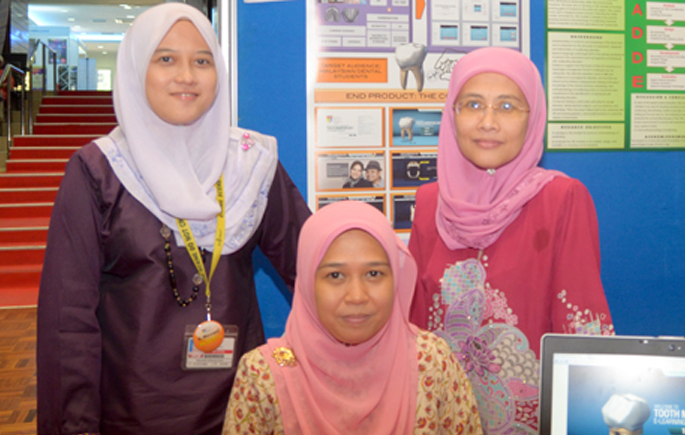Dentistry Faculty’s New Way To Teach Teeth Sculpting
 By Saiful Bahri Kamaruddin
By Saiful Bahri Kamaruddin
Pix Ikhwan Hashim
BANGI, 24 February 2015 – Dental students at The National University of Malaysia (UKM) may soon be learning how to design and sculpt false teeth with dental wax using computer software of interactive instructional manual that renders animated three-dimensional images.
Dr Nor Atika Mohd Ashar of the Faculty of Dentistry, who is on the team developing the software, said the basic idea of the project was to develop a method to help first-year dentistry students understand the sculpting of teeth apart from learning from textbooks and lectures.
Dr Nor Atika, told UKM News Portal at the recent K-Novasi Teaching and Learning Carnival here that a more economically viable alternative to the expansive imported instructional manuals was needed to reduce operating costs.
She and Deputy Dean of the Faculty Dr Dalia Abdullah and the head of the Department of Orthodontics Dr Alizae Marny Fadzlin Syed Mohamed worked on the project for two years after being awarded a government grant of RM30,000.
Without the module called ‘Tooth Morphology Courseware’, the only way for students to learn about it was through showing diagrams in charts and text books, which only have two dimensional pictures.
She said it was difficult to instruct students through conventional means on the intricate steps of sculpting teeth as it deals with a scenario on a small scale.
The courseware consists of a step-by-step storyboard showing the methods of shaping the teeth using dental wax. Students can follow the programme that would be made available online at their own pace.
It is an interactive learning-based method where students can evaluate their progress through answering questions and feedback at workshops.
Despite teething problems in rendering the 3D images online, Dr Nor Atika was confident that they would eventually get computer graphics specialists to resolve the issue.
The courseware covers all the details found in reference books and lectures so that students can refer back to it after they had gone through their lessons. In its complete form, the module should also be certified by international dental accreditation bodies.
It was hoped that an interactive-style of learning would be more enjoyable and rewarding for the people who used it.
The faculty hopes to implement the courseware in its curriculum and get feedback from all parties – including students – so that they can make upgrades continuously. If successful, the researchers hope to publish the results and market the courseware to other universities initially to local institutions.
The faculty proposed that it be made online only so as to control its use and deter copyright infringements.
The method was shown at the recent K-Novasi Teaching and Learning Carnival on a laptop stored in the computer’s hard-disc.
![]()
